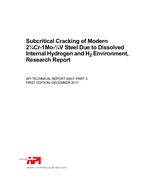Description
This recommended practice (RP) addresses only the safety aspects of hot work performed on petroleum storage tank bottoms. It discusses safety precautions for preventing fires, explosions, and associated injuries. The term “hot work,” as used in this publication, is defined as an operation that can produce a spark or flame hot enough to ignite flammable vapors. API Recommended Practice 2009 provides more in-depth information on safe hot work practices, and its requirements are not duplicated here.
This RP does not contain all safety precautions and procedures that may be required prior to, during, or after a specific hot work activity. All hot work should be performed in compliance with applicable federal, state, and local regulatory requirements and recognized industry practices. Work practices of concern for working on tank bottoms include, but are not limited to, confined space entry, lockout/tagout, atmospheric testing, ventilation, and requirements for use of personal protective equipment (PPE). API Standard 2015 provides guidance for tank entry consistent with OSHA regulations noted in Section 2, Normative References. This RP does not repeat the detailed information provided in the referenced documents. Some of the relevant OSHA regulations from 29 CFR Part 1910 and 29 CFR Part 1926 are included in the references. It is the responsibility of each organization to review and comply with applicable regulatory requirements.
This RP does not cover the following:
– guidance for compliance with safety or environmental regulations or codes;
– engineering specifications for tank construction or rebuilding (see API tank standards);
– specific guidance for repair of shop-fabricated tanks, which is addressed by STI/SPFA SP031. These tanks include those built to UL 142, API 650, STI/SPFA aboveground tank standards, as well as others;
– specific guidance for tank entry (see API 2015);
– welding techniques, craft skills, or qualification of welders (see referenced welding standards);
– normal “safe work” practices such as fall protection, PPE, slip/trip/fall, etc.;
– entry or work in inert environments (see API 2217A);
– entry into confined spaces for construction activities (see OSHA 29 CFR Part 1926, Subpart AA, and Part 1926.1200).
Product Details
- Edition:
- 8th
- Published:
- 04/01/2022
- Number of Pages:
- 28
- File Size:
- 1 file , 400 KB
- Product Code(s):
- K22078, K22078, K22078
- Note:
- This product is unavailable in Russia, Cuba, Syria, North Korea, Ukraine, Belarus, Iran




